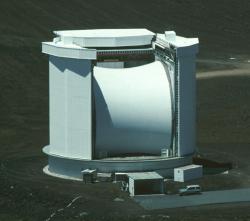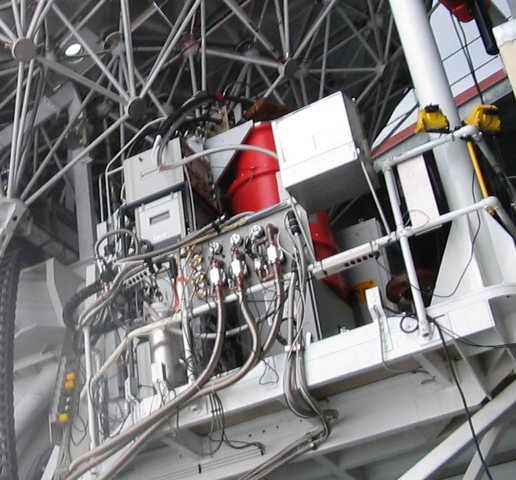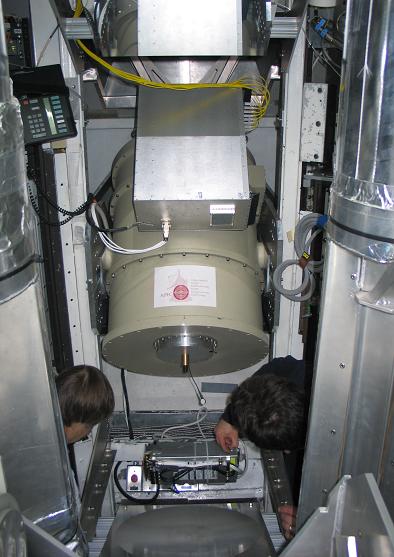Home
Instruments
Maps
Multiwavelength
Publications
Data Products
Consortium
Future
Consortium Only Site
(Password required)
|
The Instruments
|
JCMT
The
James
Clark
Maxwell
Telescope
is located close to the summit of Mauna Kea, Hawaii, at
an altitude of 4092 metres.
With a diameter of 15 metres, it is the largest
astronomical telescope in the world
designed to operate at submillimetre wavelengths.
More information about the JCMT is available at the
JCMT
home page.
|

The JCMT which housed the SCUBA and AzTEC instruments.
|
SCUBA
The
Submillimetre
Common
User
Bolometer
Array was a
submillimetre continuum array receiver which
operated at the JCMT between 1997 and 2006.
SCUBA was composed of two arrays of bolometers that viewed the same
2.3 sq. arcmin of sky
simultaneously, a long wave array of 37 bolometers
used
at 850μm and a short wave array of 91 detectors used at
450μm. SCUBA's original design allowed for
observations also at 350, 750, 1100, 1300 and 2000
microns, but due to engineering problems which began
in 1997, these windows were not used.
The beam size was ∼15 arcseconds at 850μm and
∼7.5 arcseconds at 450μm.
The pixels were arranged in a hexagonal pattern, with the
feedhorns close-packed. The bolometer performance improved with
decreasing temperature, so SCUBA had a helium
cooling system to cool it to below 100mK to
improve detector sensitivity. Thermal noise from the sky and local
surroundings dominates at millimetre wavelengths.
More information about SCUBA is available at the
SCUBA
home page.
|

The SCUBA instrument
|
AzTEC
Astronomical
Thermal
Emission
Camera
(AzTEC) is a 144-pixel millimeter-wavelength camera
that operates at either 1.1mm or 2.1mm. Radiation
is coupled to Si-Ni "spider-web" bolometers,
arranged in a close-packed
hexagonal pattern, with an array of conical
feedhorns separated by 1.4
fλ. Scanning of the telescope or
movements of the secondary mirror provide fully-sampled images.
The detector array is cooled to ~250 mK via a
three-stage, closed-cycle
3He refrigerator.
The field-of-view of AzTEC on the LMT is 2.4
sq. arcmin and,
with a per pixel sensitivity of ~3
mJyHz-1/2 and FWHM beam-size
of 6 arcsecs at 1.1mm, AzTEC has an extremely
fast mapping-speed of ~0.36
deg2
/hr/mJy2.
AzTEC was successfully installed and commissioned at the JCMT
in June 2005, and undertook an extensive program of guest
observations on the JCMT in November & December 2005 on
behalf of the SHADES project. More information about the
instrument is available at the
AzTEC home page.
|

The AzTEC instrument.
|
|


